- Exhibits
- Tet Offensive
- Hue
- Retaking Hue
The Tet Offensive (Tết Mậu Thân)
- The Tet Offensive (Tết Mậu Thân)
- Hue: The Imperial City
- The Battle of Khe Sanh
- The Battle for Saigon
- Aftermath of the BattlesPolitical ConsequencesExhibit Credits
Retaking Hue: South of the Perfume River
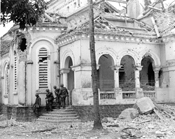
(117) After the Battle--"A"Co., First Battalion, First Regiment Marines leave church after successfully capturing if from North Vietnamese control during one of the bloody battles taking place in Hue
(Brigadier General Edwin H. Simmons Collection [va020950])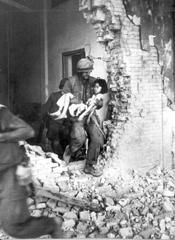
A US Marine carries a seriously wounded Vietnamese child from the ruins of a home in Hue. The provincial capital city was the target of violent VC attacks following the start of the Tet
(Douglas Pike Photograph Collection [va006852])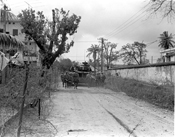
(048) Street Shield-- Marines use a M-48 tank as cover as they advance during street fighting in Hue, Feb. 3
(Brigadier General Edwin H. Simmons Collection [va020881])Those involved in reclaiming Hue witnessed some of the most bloody, frustrating, and uncompromising combat of the Tet Offensive. Because the city had been effectively cut into two parts—the Citadel north of the Perfume River and the rest of Hue south of the river—the effort retake the city developed as two separate battles. The fighting south of the river was under the operational control of Task Force X-Ray, commanded by USMC Brig. Gen. Foster LaHue in nearby Phu Bai. Based out of the Military Assistance Command Vietnam (MACV) compound near the Perfume River, American Marine units that had been moved to Hue in the wake of the attack would begin the extremely difficult and costly task of dislodging communist forces from their well-established defensive positions throughout the city’s southern half. The battle for the south of Hue would belong to the Marines.
I remember the radioman because there are people that just stick in your mind because they’re beautiful. He was every girl’s high school sweetheart dream; tall, blonde, handsome, always a good word, and he lost both his legs, and that was that.
- Robert Scott Dawson [Oral History #OH0211], Transcript page 32 lines 12-14 .
(complete interview; transcript; more information)Units from the 1st and 5th USMC regiments were tasked with fighting on this urban battlefield. Trained and conditioned to take the fight to the enemy in the jungles and rice paddies of Vietnam, the Marines encountered combat like they had never seen. With enemy troops soundly entrenched in multi-story buildings in their area of operations, the Marines had to abandon the style of warfare they had practiced to this point in the war. Small squads carefully worked their way between buildings, streets, and alleys, seemingly always under enemy fire. The fighting in Hue was from building to building, and often from room to room, and casualties were appallingly high. The Marines measured progress not by miles, kilometers, or even city blocks; progress was measured in feet and yards. Even though the restrictions against artillery and air strikes in Hue were lifted early on in the fighting, the low clouds, persistent overcast, and constant drizzling rain kept air and artillery support at a disappointing minimum for most of the battle.
The next day there was a fight over a church and again, the combat is just confusing. You don’t know what’s going. Someone has to know what’s happening but you’re just not clear in terms of what your place is. People are shooting, people are firing back, there’s noise, you hear a yell, the only thing that you understand is either, ‘Go there,’ or ‘Come here!’ You just rattle through it and try and keep your wits and your ears open so that you don’t get left behind.
- Robert Scott Dawson [Oral History #OH0211], Transcript page 35 lines 12 – 17 .
(complete interview; transcript; more information)Despite the surprising strength and tenacity of the communist forces, as well as a bedeviling lack of timely and accurate intelligence about the developing situation in Hue, the Marines remained tenacious in their advance. Improvising urban warfare methods as they advanced, the Americans soon became adept at maneuver, clearing buildings, and using whatever heavy weapons they could bring to bear against the equally resilient PAVN and VC. Slowly, and with very heavy losses, the Marines persistently moved to clear each room, and eventually each building south of the Perfume until the communists’ ability to muster a defense finally melted away. After a week of this bloody, city fighting, the Marines finally secured the area. Although this part of the battle was thankfully over, the battle for the Citadel was still raging on.
[T]hat first day of Tet was just a blur. Everywhere you went you were being shot at. We were moving troops frantically here, there, and everywhere. Fuel, rearm, move troops, shoot it out with them, come back and stick your finger in bullet holes and check them to make sure you can still fly with them then refuel, rearm, and move troops.
- Bill Quigley [Oral History #OH0299], Transcript page 37 lines 22 – 25 .
(complete interview; transcript; more information)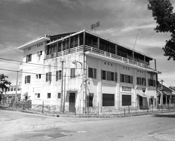
cc 35410 Hue, Vietnam Buddhist Demonstration The Hue MACV Advisory detachment building. 14-15 June 66
(Peter Braestrup Collection [va035344])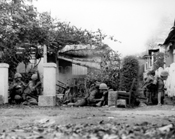
(026) During operation Hue City in Vietnam, marines of "L" Company, 3rd Battalion, Fifth Marines, effectively use walls and buildings as cover during their advance against the enemy
(Brigadier General Edwin H. Simmons Collection [va020859])
Vietnam Center & Sam Johnson Vietnam Archive
-
Address
Texas Tech University, Box 41041, Lubbock, TX 79409 -
Phone
(806)742-9010 -
Email
vnca@ttu.edu

